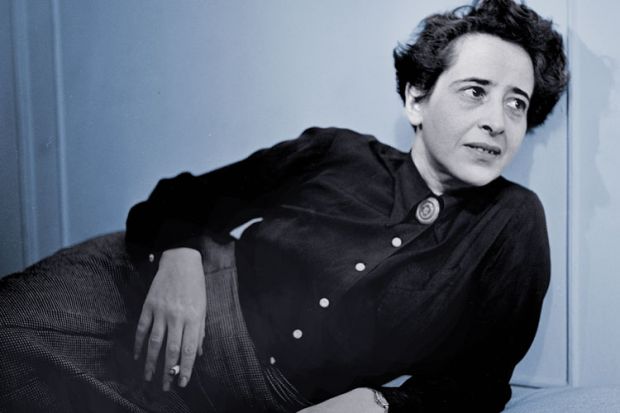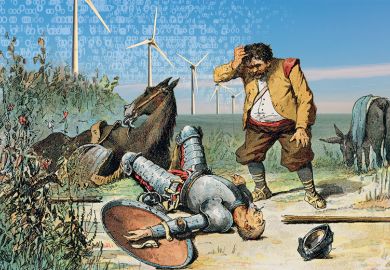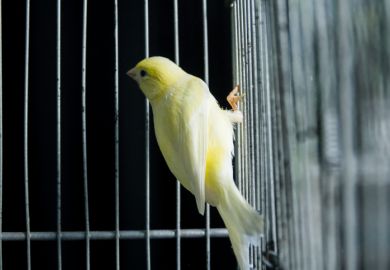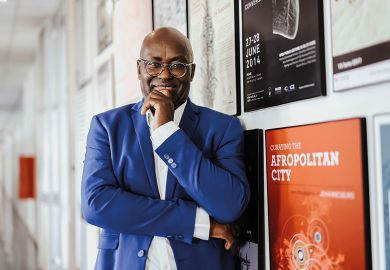Source: Alamy
Universities are – if nothing else – places where people meet to think together. Hannah Arendt passed through many such places in the course of her life, but never defined herself as an academic. She was – first and last – a thinker. She thought about many things, but particularly about the nature and purpose of thinking itself: its ethical and political significance, its potential for good and evil, its grounding in the commonality of human consciousness. Forty years after her death, her work is a reminder of the urgent need for us to learn how to think together – and how to imagine the university as a place in which such thinking matters.
Arendt was born on 14 October 1906 in what is now part of Hanover in Germany. Three years later, she and her parents moved to Königsberg. In the early to mid-1920s, she studied at the universities of Berlin, Marburg and Heidelberg. As an 18-year-old undergraduate, she embarked on a sexual and deeply emotional affair with Martin Heidegger – a 36-year-old married professor whose work had already received international acclaim. After the Reichstag fire in Berlin in 1933, she fled to Paris via Prague and Geneva and began 18 years as a stateless person. After escaping from the internment camp at Gurs in occupied France, she arrived in the US by way of Spain and Lisbon in May 1941. Ten years later, she gained US citizenship. In 1974, she suffered a heart attack while delivering her Gifford Lecture series on “The Life of the Mind” at the University of Aberdeen. A year later, she suffered another heart attack in New York and died on 4 December 1975 at the age of 69. Always – in thought as in life – she was on the move.
In her final, unfinished work, The Life of the Mind, Arendt distinguished between thinking conducted in isolation with oneself – the “two-in-one” of thinking as she put it – and thinking that constitutes “the dialogue of thought” with others. In both cases, different viewpoints and standpoints are, in her terms, “represented” through either internal dialogue or thinking together with others. Because thinking inflects inward to the self and outward to the other, it is, she claimed, grounded in common experience and “not a prerogative of the few but an ever present faculty in everybody”. Thinking is ordinary, everyday, commonplace. It is what connects us with ourselves and with one another.
Indeed, she developed a profound suspicion of “pure thought” that isolates the thinker – not abstract thought but any kind of thinking that entraps the thinker within a closed system. This suspicion formed the basis of her 1946 assault on the “terminological façade” and “obvious verbal tricks and sophistries” that characterised her ex-lover’s magnum opus, Being and Time. The book, she claimed, was marred by Heidegger’s use of “mythologising and muddled concepts like ‘folk’ and ‘earth’”. Later – in a handwritten journal entry dated July 1953 – she likened Heidegger to a fox attempting to lure potential victims into a trap that none of them can enter because the fox is itself trapped within it.
Even when, years later in a 1969 radio broadcast, she sought to excuse Heidegger’s Nazi past, she did so on the grounds that his residency in his own exclusive world of thought had made him a stranger to the wider world of human affairs. In defending Heidegger, she was forced to highlight what for her was a serious deficiency in his thinking: its self-absorbed unworldliness from which – like the fox in her earlier journal entry – he was unable to escape. For Arendt, thinking was meant to be of the world, worldly.
That is why the notion of “thinking” played such an important part in Arendt’s analysis of totalitarianism, from her 1951 The Origins of Totalitarianism to her highly controversial coverage of the Adolf Eichmann trial, the latter culminating in her 1963 book Eichmann in Jerusalem. In this, she famously employed the phrase “the banality of evil” to describe what she saw as Eichmann’s unquestioning adherence to the norms of the Nazi regime. In concluding from the occasional lies and inconsistencies in his courtroom testimony that Eichmann was a liar, the prosecution had missed the moral and legal challenge of the case: “Their case rested on the assumption that the defendant, like all ‘normal persons’, must have been aware of the criminal nature of his acts” – but, she added, Eichmann was normal only in so far as he was “no exception within the Nazi regime”. The prosecution had, according to Arendt’s analysis, failed to grasp the moral and political significance of Eichmann’s “abnormality”: namely, his adherence to the norms of the regime he had served and therefore his lack of awareness of the criminal nature of his acts.
Later, in The Life of the Mind, Arendt returned to a consideration of the Eichmann trial, using her earlier analysis of that trial as the springboard for what were to be her final reflections on the ethics of thinking. The only notable characteristic she could detect in Eichmann “was something entirely negative: it was not stupidity but thoughtlessness”. He had displayed a complete “absence of thinking”, which, as she disturbingly pointed out, “is so ordinary an experience in our everyday life, where we have hardly the time, let alone the inclination, to stop and think”. In Arendt’s view, Eichmann’s “banality” left him no less culpable – and rendered the death sentence no less justifiable – but it shifted the basis of the argument against him: if he was a monster, then his monstrosity arose from an all too human propensity towards thoughtlessness. If Heidegger had represented the unworldliness of “pure thought”, then Eichmann represented the unworldliness of “thoughtlessness”. Neither connected with the plurality of the world as Arendt understood it. A world devoid of thinking, willing and judging would, she argued, be a world inhabited by automatons such as Eichmann who lacked freedom of will and any capacity for independent judgement.
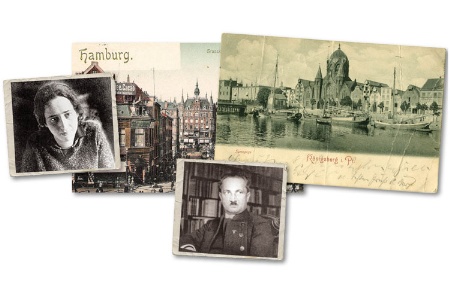
The Eichmann case raised a crucial question for Arendt: “Could the activity of thinking as such, the habit of examining whatever happens to come to pass or to attract attention, regardless of results and specific content, could this activity be among the conditions that make men abstain from evil-doing or even actually ‘condition’ them against it?” Arendt’s question arose in large part from her experience of totalitarianism, but also from her experience of political oppression under 1950s McCarthyism in the US and more generally from the ideological battle lines that defined the Cold War. She also viewed with increasing concern the unthinking consumerism and the assumption of ever increasing affluence that fuelled the American Dream prior to the stock market crash of 1973 and the oil crisis that followed later that year. Neither Hitler’s Nazism nor Stalin’s communism had, it would seem, exhausted the full potential of totalitarianism. So, the question remained urgent and pressing even within the heartlands of the democratic superpower of which she was now a citizen.
The Life of the Mind provides a tentatively affirmative response to that question: in so far as the activity of thinking requires us “to stop and think”, it may condition us against evil-doing. But this last work also raises – by implication at least – a more difficult question: could the activity of thinking not only condition us against evil-doing but predispose us towards right action? Here Arendt’s response is less clear, partly because it hinges on her suspicion of “pure thought” and partly because the final and crucial section of The Life of the Mind remained unwritten. What is clear is her insistence that without thinking that reaches out in dialogue to others there can be no informed judgement, no moral agency and no possibility of collective action – no “care for the world”.
Education was, for Arendt, an expression of that care – “the point at which”, as she wrote in her 1954 essay on “The Crisis in Education”, “we decide whether we love the world enough to assume responsibility for it”. Education provides us with a protected space within which to think against the grain of received opinion: a space to question and challenge, to imagine the world from different standpoints and perspectives, to reflect upon ourselves in relation to others and, in so doing, to understand what it means to “assume responsibility”. She had observed at first hand how such opinion can solidify into ideology. For her, thinking was diametrically opposed to ideology: ideology demands assent, is founded on certainty, and determines our behaviours within fixed horizons of expectation; thinking, on the other hand, requires dissent, dwells in uncertainty and expands our horizons by acknowledging our agency. It is the task of education – and therefore of the university – to ensure that a space for such thinking remains open and accessible.
But the university can fulfil that task only if the space it provides remains uncluttered by what Arendt saw as barriers to thought. There were – and are – two such barriers. The first is the assumption that the outcomes of thinking can be pre-specified – that we can think things through to a predetermined end or goal. Against this assumption, Arendt insisted – in her 1967 essay on “Truth and Politics” – that “our thinking is truly discursive, running, as it were, from place to place, from one part of the world to another, through all kinds of conflicting views”. Thinking is heuristic and explorative, unpredictable in its outcomes, uncertain and indeterminate. It falls outside the frame of any pedagogical approach or assessment regime premised on the notion of pre-specifiable goals, targets and outcomes.
The second barrier relates to notions of academic categorisation. Arendt understood the importance of disciplinary and methodological boundaries, but was aware that these could all too easily become barriers. In her own life and work she insisted on the need to think outside – and between – the traditional academic categories: “thinking without bannisters”, as she called it. During an interview televised in 1964, she rounded on her interviewer who referred to her as a philosopher: “I have said goodbye to philosophy once and for all. As you know, I studied philosophy, but that does not mean that I stayed with it.” Having distanced herself from that subject, she never settled into an established discipline but constantly crossed and re-crossed the boundaries between historical analysis, philosophical reflection and political theory. As she put it in her lectures on Kant’s political philosophy, what matters is “[t]o think with the enlarged mentality – that means you train your mind to go visiting”.
The public sphere was, for Arendt, the outward expression of that “enlarged mentality” – so, to “go visiting” was to journey out into that sphere. She saw education as providing a necessary transitional zone between the private and the public: a semi-public space within which we can test our opinions, interpretations and judgements and be held to provisional account for them. As Jerome Kohn – a distinguished scholar and editor of Arendt’s work and one of her former students – recalls: “In her seminar, every participant was a ‘citizen’ called upon to give his or her opinion, to insert him or herself into that miniature polis in order to make it, as she said, ‘a little better’.” This “insertion” of the self into the polis constitutes a radically new beginning – a “natality” in Arendt’s terms – by which we realise our potential as persons and as citizens.
Arendt’s work highlights the need for pedagogical approaches that recognise difference and diversity, that challenge and question, stimulate and provoke; curriculum frameworks that are open and inter-connective, flexible and responsive, negotiable and provisional; and educational purposes that focus on dispositions and qualities, on human flourishing, and on the fulfilment of individual potential. Above all, it reminds us that education is a public good: that the more we participate in it, the greater its potential contribution to the well-being of society as a whole and the vibrancy of the body politic. Against those who view education as a commodity to be bought and sold for private gain, Arendt insists that it is grounded in our shared capacity to think – and that to think is to think together.
The collective problems we now face are increasingly global in scope and as such require collective solutions, which in turn require the capacity and the will to think across our differences. In a deeply divided world, thinking together may be the most valuable resource available – and the university may be among one of the few remaining places within which that resource can be valued unconditionally.
Register to continue
Why register?
- Registration is free and only takes a moment
- Once registered, you can read 3 articles a month
- Sign up for our newsletter
Subscribe
Or subscribe for unlimited access to:
- Unlimited access to news, views, insights & reviews
- Digital editions
- Digital access to THE’s university and college rankings analysis
Already registered or a current subscriber? Login
